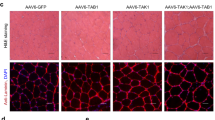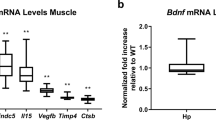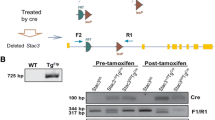Abstract
We investigated the effects of exclusive and sustained transgenic overexpression of insulin-like growth factor (IGF)-I in the central nervous system (CNS) on the age-dependent decline in muscle strength, excitation-contraction coupling, muscle innervation and neuromuscular junction postterminal architecture. We found that (1) transgenic IGF-I overexpression in the CNS does not modify the decline in extensor digitorum longus (EDL) and soleus muscle weight with aging and (2) strength significantly decreases in transgenic (Tg) compared to wild-type mice. The latter finding is consistent with (3) the decreased absolute and specific force measured in the EDL muscle in vitro and (4) the decreased charge movement and peak intracellular Ca2+ mobilization in individual muscle fibers from old IGF-I Tg mice compared to young wild-type mice, which also is associated with (5) decreased dihydropyridine receptor α1-subunit expression in old compared to young IGF-I Tg mice. (6) Tg IGF-I prevents a change in muscle fiber type that is associated with (7) improved muscle innervation and postterminal neuromuscular structure. (8) IGF-I is expressed extensively across the spinal cord gray matter and the lateral motor column. Our results raise questions about the timing and cell location of CNS IGF-I overexpression necessary to prevent or to ameliorate age-dependent alterations in the structure and function of skeletal muscle.












Similar content being viewed by others
References
Barton-Davis E.R., Shoturma D.I., Musaro A., Rosenthal N., Sweeney H.L. 1998. Viral mediated expression of insulin-like growth factor I blocks the aging-related loss of skeletal muslce function. Proc. Natl. Acad. Sci. USA 95:15603–15607
Brooks S.V., Faulkner J.A. 1988. Contractile properties of skeletal muscles from young, adult and aged mice. J. Physiol. 404:71–82
Buller A.J., Eccles J. C., Eccles R.M. 1960a. Differentiation of fast and slow muscles in the cat hind limb. J. Physiol. 150:399–416
Buller A.J., Eccles J. C., Eccles R.M. 1960b. Interactions between motoneurones and muscles in respect of the characteristic speeds of their responses. J. Physiol. 150:417–439
Caroni P., Grandes P. 1990. Nerve sprouting in innervated adult skeletal muscle induced by exposure to elevated levels of insulin like growth factors. J. Cell Biol. 110:1307–1317
Coleman M.E., DeMayo F., Yin K.C., Lee H.M., Geske R., Montgomery C., Schwartz R.J. 1995. Myogenic vector expression of insulin-like growth factor I stimulates muscle cell differentiation and myofiber hypertrophy in transgenic mice. J. Biol. Chem. 270:12109–12116
Dai Z., Takahashi S.I., Van Wyk J.J., D’Ercole A.J. 1992. Creation of an autocrine model of insulin-like growth factor-I action in transfected FRTL-5 cells. Endocrinology 130:3175–3183
Delbono O. 2003. Neural control of aging skeletal muscle. Aging Cell 2:21–29
D’Ercole A.J., Ye P., O’Kusky J.R. 2002. Mutant mouse models of insulin-like growth factor actions in the central nervous system. Neuropeptides 36:209–220
Dobrowolny G., Giacinti C., Pelosi L., Nicoletti C., Winn N., Barberi L., Molinaro M., Rosenthal N., Musaro A. 2005. Muscle expression of a local IGF-I isoform protects motor neurons in an ALS mouse model. J. Cell Biol. 168:193–199
Eddinger T.J., Cassens R.G., Moss R.L. 1986. Mechanical and histochemical characterization of skeletal muscles from senescent rats. Am. J. Physiol. 251:C421–C430
Einsiedel L.J., Luff A.R. 1992. Effect of partial denervation on motor units in the ageing rat medial gastrocnemius. J. Neurol. Sci. 112:178–184
Fervenza F.C., Tsao T., Hsu F., Rabkin R. 1999. Intrarenal insulin-like growth factor-1 axis after unilateral nephrectomy in rat. J. Am. Soc. Nephrol. 10:43–50
Fitts R.H., Troup J.P., Witzmann F.A., Holloszy J.O. 1984. The effect of ageing and exercise on skeletal muscle function. Mech. Ageing Dev. 27:161–172
Florini J.R., Ewton D.Z., Coolican S.A. 1996. Growth hormone and insulin growth factor system in myogenesis. Endocr. Rev. 17:481–517
Giulian G.G., Moss R.L., Greaser M. 1983. Improved methodology for analysis and quantitation of proteins on one dimensional silver-stained slab gels. Anal. Biochem. 129:277–287
Gonzalez E., Messi M.L., Delbono O. 2000. The specific force of single intact extensor digitorum longus and soleus mouse muscle fibers declines with aging. J. Membr. Biol. 178:175–183
González E., Messi M.L., Zheng Z., Delbono O. 2003. Insulin-like growth factor-1 prevents age-related decrease in specific force and intracellular Ca2+ in single intact muscle fibres from transgenic mice. J. Physiol. 552:833–844
Greensmith L., Vrbova G. 1996. Motoneurone survival: A functional approach. Trends Neurosci. 19:450–455
Hashizume K., Kanda K., Burke R. 1988. Medial gastrocnemius motor nucleus in the rat: Age-related changes in the number and size of motoneurons. J. Comp. Neurol. 269:425–430
Kadhiresan V.A., Hassett C.A., Faulkner J.A. 1996. Properties of single motor units in medial gastrocnemius muscles of adult and old rats. J. Physiol. 493:543–552
Kanda K., Hashizume K. 1989. Changes in properties of the medial gastrocnemius motor units in aging rats. J. Neurophysiol. 1989:737–746
Kanje M., Skottner A., Sjoberg J., Lundborg G. 1989. Insulin-like growth factor I (IGF-I) stimulates regeneration of the rat sciatic nerve. Brain Res. 486:396–398
Knudson C.M., Chaudhari N., Sharp A.H., Powell J.A., Beam K.G., Campbell K.P. 1989. Specific absence of the alpha 1 subunit of the dihydropyridine receptor in mice with muscular dysgenesis. J. Biol. Chem. 264:1345–1348
Lang C.H., Frost R.A., Svanberg E., Vary T.C. 2004. IGF-I/IGFBP-3 ameliorates alterations in protein synthesis, eIF4E availability, and myostatin in alcohol-fed rats. Am. J. Physiol. 286:E916–E926
Larsson L., Ansved T. 1995. Effects of ageing on the motor unit. Prog. Neurobiol. 45:397–458
Leung A.T., Imagawa T., Campbell K.P. 1987. Structural characterization of the 1,4-dihydropyridine receptor of the voltage-dependent Ca2+ channel from rabbit skeletal muscle. Evidence for two distinct high molecular weight subunits. J Biol Chem. 262:7943–7946
Lexell J. 1995. Human aging, muscle mass, and fiber type composition. J. Gerontol. A Biol. Sci. Med. Sci. 50:11–16
Li D., Sweeney G., Wang Q., Klip A. 1999. Participation of PI3K and atypical PKC in Na+-K+-pump stimulation by IGF-I in VSMC. Am. J. Physiol. 276:H2109–H2116
Li J.B., Wang C.Y., Chen J.W., Feng Z.Q., Ma H.T. 2004. Expression of liver insulin-like growth factor 1 gene and its serum level in patients with diabetes. World J. Gastroenterol. 10:255–259
Li X., Oppenheim R.W., Lei M., Houenou L.J. 1994. Neurotrophic agents prevent motoneuron death following sciatic nerve section in the neonatal mouse. J. Neurobiol. 25:759–766
Messi M.L., Delbono O. 2003. Target-derived trophic effect on skeletal muscle innervation in senescent mice. J. Neurosci. 23:1351–1359
Meyer O.A., Tilson H.A., Byrd W.C., Riley M.T. 1979. A method for the routine assessment of fore- and hindlimb grip strength of rats and mice. Neurobehav. Toxicol. 1:233–236
Mourkioti F., Rosenthal N. 2005. IGF-I, inflammation and stem cells: Interactions during muscle regeneration. Trends Immunol. 26:535–542
Murray B.E., Ohlendieck K. 1997. Cross-linking analysis of the ryanodine receptor and alpha1-dihydropyridine receptor in rabbit skeletal muscle triads. Biochem. J. 324:689–696
Musaro A., McCullagh K.J., Paul A., Houghton L., Dobrowolny G., Molinaro M., Barton-Davis E.R., Sweeney H.L., Rosenthal N. 2001. Localized IGF-I transgene expression sustains hypertrophy and regeneration in senescent skeletal muscle. Nat. Genet. 27:195–200
Neff N.T., Prevette D.M., Houenou L.J., Lewis M.E., Glicksman M.A., Yin Q.-W., Oppenheim R.W. 1993. Insulin-like growth factors: Putative muscle-derived trophic agents that promote motoneuron survival. J. Neurobiol. 24:1578–1588
O’Kusky J.R., Ye P., D’Ercole J. 2000. Insulin-Like growth factor-1 promotes neurogenesis and synaptogenesis in the hippocampal dentate gyrus during postnatal development. J. Neurosci. 15:8435–8442
Ogura H., Aruga J., Mikoshiba K. 2001. Behavioral abnormalities of Zic1 and Zic2 mutant mice: Implications as models for human neurological disorders. Behav. Genet. 31:317–324
Oppenheim R.W. 1996. Neurotrophic survival molecules for motoneurons: An embarrassment of riches. Neuron 17:195–197
Payne A.M., Delbono O. 2004. Neurogenesis of excitation- contraction uncoupling in aging skeletal musule. Exerc Sport Sci Rev. 32:36–40
Payne A.M., Zheng Z., Messi M.L., Milligan C.E., Gonzalez E., Delbono O. 2006. Motor neurone targeting of IGF-I prevents specific force decline in ageing mouse muscle. J. Physiol. 570:283–294
Pestronk A., Drachman D.B. 1978. A new stain for quantitative measurement of sprouting at neuromuscular junctions. Muscle Nerve 1:70–74
Pette D., Staron R.S. 2001. Transitions of muscle fiber phenotypic profiles. Histochem. Cell Biol. 115:359–372
Popken G.J., Hodge R.D., Ye P., Zhang J., Ng W., O’Kusky J.R., D’Ercole A.J. 2004. In vivo effects of insulin-like growth factor-I (IGF-I) on prenatal and early postnatal development of the central nervous system. Eur. J. Neurosci. 19:2056–2068
Rabinovsky E.D., Gelir E., Gelir S., Lui H., Kattash M., DeMayo F.J., Shenaq S.M., Schwartz R.J. 2003. Targeted expression of IGF-I transgene to skeletal muscle accelerates muscle and motor neuron regeneration. FASEB J. 17:53–55
Renganathan M., Messi M.L., Delbono O. 1998. Overexpression of IGF-I exclusively in skeletal muscle prevents age-related decline in the number of dihydropyridine receptors. J. Biol. Chem. 273:28845–28851
Sacco A., Regis D., LaBarge M.A., Hammer M.M., Kraft P., Blau H.M. 2005. IGF-I increases bone marrow contribution to adult skeletal muscle and enhances the fusion of myelomonocytic precursors. J. Cell Biol. 171:483–492
Segal S.S., Faulkner J.A. 1985. Temperature-dependent physiological stability of rat skeletal muscle in vitro. Am. J. Physiol. 248:C265–C270
Serrano A.L., Petrie J.L., Rivero J.L.L., Hermanson J.W. 1996. Myosin isoforms and muscle fiber characteristics in equine gluteus medius muscle. Anat. Rec. 244:444–451
Sonntag W.E., Ramsey M., Carter C.S. 2005. Growth hormone and insulin-like growth factor-1 (IGF-I) and their influence on cognitive aging. Ageing Res. Rev. 4:195–212
Stanfield B.B., Cowan W.M. 1979. The morphology of the hippocampus and dentate gyrus in normal and reeler mice. J. Comp. Neurol. 185:393–422
Su J.L., Stimpson S., Edwards C., Van Arnold J., Burgess S., Lin P. 1997. Neutralizing IGF-I monoclonal antibody with cross-species reactivity. Hybridoma 16:513–518
Tsien R.W., Pozzan T. 1989. Measurement of cytosolic free Ca2+ with quin2: Practical aspects. Methods Enzymol. 172:230–262
Wang Z.-M., Messi M.L., Delbono O. 2000. L-type Ca2+ channel charge movement and intracellular Ca2+ in skeletal muscle fibers from aging mice. Biophys. J. 78:1947–1954
Wang Z.-M., Messi M.L., Delbono O. 2002. Sustained overexpression of IGF-I prevents age-dependent decrease in charge movement and intracellular calcium in mouse skeletal muscle. Biophys. J. 82:1338–1344
Wang Z.M., Messi M.L., Delbono O. 1999. Patch-clamp recording of charge movement, Ca2+ current and Ca2+ transients in adult skeletal muscle fibers. Biophys. J. 77:2709–2716
Ye P., Li L., Richards R.G., DiAugustine R.P., D’Ercole A.J. 2002. Myelination is altered in insulin-like growth factor-I null mutant mice. J. Neurosci. 22:6041–6051
Ye P., Xing Y., Dai Z., D’Ercole J. 1996. In vivo actions of insulin-like growth factor-I (IGF-I) on cerebellum development in transgenic mice: Evidence that IGF-I increases proliferation of granule cells progenitors. Dev. Brain Res. 95:44–54
Zhang C., Goto N., Suzuki M., Ke M. 1996. Age-related reductions in number and size of anterior horn cells at C6 level of the human spinal cord. Okajimas Folia Anat. Jpn. 73:171–177
Zheng Z., Wang Z.M., Delbono O. 2002. Insulin-like growth factor-1 increases skeletal muscle DHPR alpha1S transcriptional activity by acting on the cAMP-response element-binding protein element of the promoter region. J. Biol. Chem. 277:50535–50542
Zheng Z., Wang Z.M., Delbono O. 2004. Ca2+ calmodulin kinase and calcineurin mediate IGF-I-induced skeletal muscle dihydropyridine receptor alpha1S transcription. J. Membr. Biol. 197:101–112
Acknowledgement
The present study was supported by grants from the National Institutes of Health-National Institute on Aging (AG13934 and AG15820) and the Muscular Dystrophy Association (to O. D.), the National Institute for Human Development (NIHD) (HD008299, to J. A. D.) and the Wake Forest University Claude D. Pepper Older Americans Independence Center (P30-AG21332). We thank Ms. Julie Edelson for editing the manuscript.
Author information
Authors and Affiliations
Corresponding author
Additional information
Ramón Jiménez Moreno and María Laura Messi contributed equally to this work.
Rights and permissions
About this article
Cite this article
Moreno, R.J., Messi, M.L., Zheng, Z. et al. Role of Sustained Overexpression of Central Nervous System IGF-I in the Age-Dependent Decline of Mouse Excitation-Contraction Coupling. J Membrane Biol 212, 147–161 (2006). https://doi.org/10.1007/s00232-006-0044-z
Received:
Revised:
Published:
Issue Date:
DOI: https://doi.org/10.1007/s00232-006-0044-z




